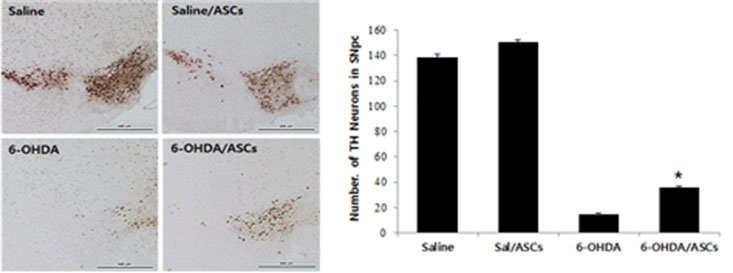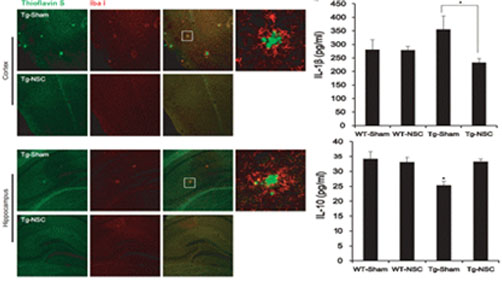연구
Research
기초뇌과학연구부
Division of Basic Neuroscience
기초뇌과학연구부 연구 개요 (Research outline of the Division of Basic Neuroscience)
장근아 교수, Prof. Keun-A CHANG
1
정서인지연구센터 (Research Center for Cognition & Emotion)
-
1. 동물 모델을 이용한 뇌 질환 연구
우리 연구센터에서는 퇴행성 뇌질환 및 정신질환 동물 모델을 구축하고 행동분석으로 모델 구축 여부를 평가한다. 이 모델 동물을 이용하여 뇌영상 이미징 분석과 조직학적·생화학적 분석을 통해 질환 특성과 발병 기전을 연구한다. 이같은 연구를 통하여 얻은 결과를 아래의 국제학술지에 다수 발표하였다.
-
1. Diagnosis of brain diseases
Our research center establishes animal models for degenerative brain diseases and mental disorders and confirms whether to build models with behavioral analysis. By using the model animals, the characteristics and pathogenesis of these diseases have been are studied through brain imaging imaging analysis, and histologic/ biochemical analysis. The results of these studies have been published in the following international journals.
-
2. 뇌 질환 진단 및 치료에 대한 연구
노화 관련 뇌질환의 대표질환인 알츠하이머 치매와 파킨슨 질환의 조기 진단을 위한 바이오마커 연구와 줄기세포, 유전자 조절, 약물 등에 의한 치료법 개발 연구를 수행하였고, 이를 통해 다수의 특허를 얻었다.
-
2. Studies on diagnosis and treatment of Brain Diseases
The following research have been carried out which are on biomarkers for early diagnosis of Alzheimer's dementia and Parkinson's disease, which are representative diseases of aging-related brain diseases, and on treatment methods by stem cells, gene control, and drugs. and a number of patents were obtained.
-
3. 파킨슨 질환 연구
줄기세포를 이용한 파킨슨 질환의 치료는 오랜 동안 많은 연구자들에 의해 주목을 받아 왔으나 작용 기전 및 효과에 대해서는 확실하지 않다.. 본 연구에서는 사람의 지방 유래 줄기세포의 파킨슨 질환 효과를 확인하고자 하였다. 사람 지방 유래 줄기세포를 6-hydroxydopamine (6-OHDA)로 유도한 파킨슨 질환 마우스의 꼬리 정맥에 주입하였을 때 마우스는 약 3주 후 다음과 같은 변화를 보였다. 1) 행동 능력에서 유의한 상승, 2)도파민 신경세포의 손상 회복 및 3) 세포 내 미토콘드리아의 구조적인 손상의 감소와 감소된 미토콘드리아 복합체1의 활성 증가를 확인하였다. 이러한 결과는 사람의 지방유래 줄기세포 주입가 파킨슨 질환에서 나타나는 미토콘드리아 손상 및 기능 저하를 회복시킴으로써 치료제로써의 잠재성을 가지고 있다고 판단하였다
(Neurobiology of aging 2015, 권 페이지). -
3. Studies on Parkin’s diseases
Treatment of Parkinson's disease using stem cells has long been in the spotlight by many researchers, but it is not clear about its mechanism of action and effectiveness. We tried to determine the effect of human fat-derived stem cells on Parkinson's disease. When human fat-derived stem cells were injected into the tail vein of a Parkinson's disease mouse that induced by 6-OHDA, the mouse showed the following changes after about three weeks. 1) significant improvement in behavioral capacity, 2) recovery of damage to dopamine nerve cells, 3) reduction of structural damage to mitochondria and increase of reduced activity of mitochondrial complex1. These results suggest that human fat-derived stem cell has a therapeutic potential to Parkinson's disease by recovering mitochondrial damage and deteriorated function.
(Neurobiology of aging 2015, 권 페이지).

-
4-1. 알츠하이머 치매 연구
알츠하이머 치매 치료에 줄기세포의 이용은 오랜 시간 동안 많은 연구자들에 의해 주목을 받고 있으나 아직 효과 및 작용 기전은 확실히 밝혀져 있지 않다. 본 연구에서는 신경 유래 줄기세포의 알츠하이머 치매 질환에 대한 효과를 확인하고자 하였다.신경줄기세포를 알츠하이머 병 형질 전환 마우스 모델 (Tg2576)의 해마 및 뇌실 내에 주입하고 행동 및 병리학적 검사를 통해 치료 효능을 검토하였다. 알츠하이머 치매의 후기 단계에 줄기세포를 주입한 알츠하이머 치매 동물 모델 마우스에서는 치료 효능을 확인하지 못하였다. 반면, 초기 단계에 주입한 마우스에서는 인지 및 기억 능력 회복, 아밀로이드 베타 침착 프라그 형성 뿐만 아니라 뇌 내 줄기세포의 분화 증가 및 시냅스 안정성 관련 단백질들이 증가가 관찰되었다. 이 같은 결과는 적절한 시기의 이식은 알츠하이머 치매 질환에서 치료 효과가 있을 것으로 예측되었다. (Cell death and disease, 권 페이지2015).
-
4-1. Studies on Alzheimer dementia
The use of stem cells in the treatment of Alzheimer's dementia has long drawn attention from many researchers, but the effect and mechanism of action has yet to be clearly revealed. In this study, it wa tried to identify the effects of nerve-derived stem cells on Alzheimer's dementia. Neurostem cells were injected into the hippocampus and ventricle of the Alzheimer's disease model mouse (Tg2576) by genetic alteration and behavioral and pathological tests were performed. When the stem cells were injected into the model mouse in the later stage of the disease, the effect of treatment was not observed. On the other hand, When the stem cells were injected the mice i in the early stages we observed an increase in cognitive and memory abilities, decrease in the formation of amyloid beta-deposition praque as well as the increase in stem cell differentiation in the brain and the increase in proteins related to synaptic stability. The results showed that transplants of the neuro-stem cells at an appropriate time in the disease progress were expected to be effective in treating Alzheimer's disease. (Cell death and disease, 권 페이지2015).

- This figure shows that neuro-stem cell injection into Animal Models of Alzheimer's dementia improves the memory of the animals, that was confirmed by Water Maze test.
- This figure shows that neuro-stem cell injection into animal models of Alzheimer's dementia decreased the accumulation of amyloid plaque in the cerebral cortex and hippocampus, which was confirmed by immuno-histochemical analysis.

- This figure shows the neuro-stem cell injection into animal models of Alzheimer's dementia in the mild stage of the symptom increases the activity of microglial cells.

- This figure shows the neuro-stem cell injection into animal models of Alzheimer's dementia in the mild stage of the symptom increases the regeneration and synaptic plasticity of brain nerve cells.
-
4-2. 알츠하이머 치매 연구
알츠하이머 치매 치료제는 현재 개발 중에 있다. 본 연구에서는 예방 및 치료 효능의 잠재성을 가진 DHED 유도체 (cx-DHED)를 이용하여 치료 효과를 확인하고자 하였다. 4개월된 5xFAD 알츠하이머병 형질 전환 마우스 모델에 약물을 2개월간 복강으로 주입하고 행동 및 병리학적 검사를 통해 효능을 관찰하여 다음과 같은 결과를 얻었다. 1) 인지 및 기억 능력이 회복, 2) 아밀로이드 베타 plaque 형성 감소, 3) 인산화된 타우 단백질 침착의 유의적 감소, 4) 시냅스의 안정성 관련된 단백질들의 증가. 이상의 결과로 부터 cx-DHED는 알츠하이머 치매 질환에서 나타나는 인지 및 기억력 손상을 회복 등 치료제로써의 잠재성을 가지고 있을 것으로 추정하였다 (Fontiers in Behabioral Neuroscience, 2018 권, 페이지).
-
4-2. Studies on Alzheimer dementia
Alzheimer's dementia treatments are currently under development. The purpose of this study was to identify therapeutic effects of cx-DHED (DHED derivatives) which has been suggested to have the potential for preventive and therapeutic effect. cx-DHED was injected to the 4-month-old 5xFAD mice (Alzheimer's disease model mouse developed by genetic alteration) intraperitoneally for two months. The effects was assessed through behavioral and pathological tests and the following results were obtained. 1) Recovery of cognitive and memory abilities; 2) reduction of amyloid beta plaque formation; 3) significant reduction of phosphorylated tau protein concentration; 4) increase of proteins related to the stability of synapses. These results suggest that cx-DHED has therapeutic potential for Alzheimer's dementia (Fontiers in Behavioral Neuroscience, 2018 권, 페이지).

- These figures shows that cx-DHED has the effect to reduce the accumulation of amyloid plaque in the cerbral cortex and hippocampus, which was confirmed by immuno-histochemical analysis in the animal models of Alzheimer's dementia.
-
5. 정신질환 연구
자폐증에 대한 발병 기전 및 치료법은 현재 연구 중에 있다. 본 연구에서는 신경 유래 줄기세포가 자폐증에 치료효과가 있는 지를 알아 보고자 하였다. 자폐증 모델 마우스를 항경련제인 밸프로산(valporic aicd, VPA) 투여로 만든 후 지방 유래 줄기세포를 투여하고 행동분석을 통하여 효과를 평가하였다. 그 결과 줄기세포를 투여 받은 마우스에서는 반복 이상 행동 및 사회적 상호작용 저하 및 불안 행동 등이 현저하게 개선됨이 관찰되었다 (Behavioural Brain Research, 권, 페이지 2016). 신경 줄기세포, 지방줄기세포, 어느것?
-
5. Studies on psychiatric diseases
The pathogenesis and treatment of autism are currently under study. In this study, the efforts were made to find out if nerve-derived stem cells are effective in treating autism. The effects were evaluated through behavioral analysis after injecting fat tissue-derived stem cells into autism model mice which was made by the administration of valproic acid (VPA), an anticonvulsant drug. As a result, it was observed that mice injected with stem cells significantly improved repetitive abnormal behavior, decreased social interaction, and anxiety behavior(Behavioural Brain Research, 권, 페이지 2016).

- This figures show that abnormal behaviors were reduced in autism model mice through the injection of the 신경 or 지방 stem cells. The effects were evaluated by the behavioral analysis method.
- This figures show that the formation of amyloid plaque in hippocampus was reduced in autism model mice through the injection of the 신경 or 지방 stem cells. Amyloid plaque was detected by Immuno-histochemical analysis.
-
6. 뇌염증 동물 모델을 이용한 PET probe 연구
LPS를 뇌에 주입하여 뇌염증 랫 모델을 만들고, TSPO ligand를 타겟하는 PET probe (18F]14a) 를 개발하여 뇌염증을 PET 영상을 통하여 효능을 평가하였음 (European J. Medicinal Chemistry, 권, 페이지 2018).
-
6. Studies on PET probe using an animal model of brain inflammation)
A rat model for encephalitis was prepared by injecting LPS into the brain and PET probe (18F]14a) targeting TSPO ligand was created. Using these rats and probe, the extent of brain inflammation was evaluate through PET images (Europian J. Medical Chemistry, 권, 페이지 2018).

- Brain micro-PET images obtained by [18F]14a, a novel small molecule probe targeting TSPO.

- Results show that the inflammatory areas shown in PET images in animal models of encephalitis induced by LPS are identified through immuno-histochemical methods.

